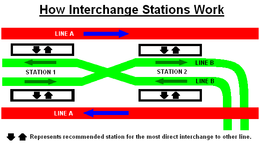
Back 対面乗り換え Japanese 평면 환승 Korean Cross-platform-overstap Dutch Кросс-платформенная пересадка Russian Cross-platform interchange SIMPLE Кросплатформова пересадка Ukrainian 跨月台轉車站 Chinese 跨月台轉車站 ZH-YUE
This article needs additional citations for verification. (July 2008) |
A cross-platform interchange is a type of interchange between different lines at a metro (or other railway) station. The term originates with the London Underground;[1] such layouts exist in other networks but are not commonly so named. In the United States and Canada, it is often referred to as a cross-platform transfer.
This configuration occurs at a station with island platforms, with a single platform in between the tracks allocated to two directions of travel, or two side platforms between the tracks, connected by level corridors. The benefit of this design is that passengers do not need to use stairs to another platform level for transfer. A cross-platform interchange arrangement may be costly to build due to the complexity of rail alignment, especially if the railway designers also arrange the track with flyovers (which is typically done to increase efficiency).
A typical bidirectional cross-platform interchange configuration consists of two outbound directions of two different lines sharing an island platform, and the respective return directions of both lines sharing a different island platform in the same station complex. Less common is a cross-platform interchange to transfer onto a continuation of same single line served by that station, for example in Kirkby, Ormskirk, and Pittsburg/Bay Point.
- ^ "Google News". Retrieved 16 March 2011.
